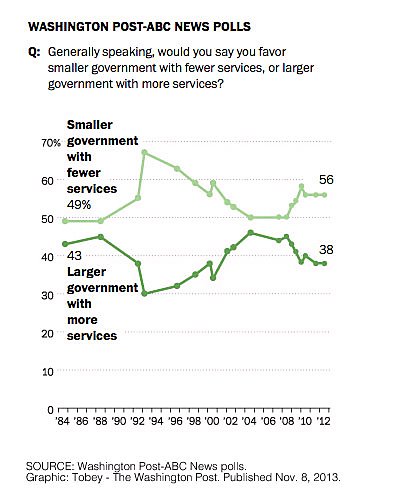Whether the recent election was good news for tea party Republicans, establishment Republicans, or activist Democrats, the Washington Post notes that
Obama’s larger project of redefining what government should do has been stymied by steady Republican opposition and public disenchantment with political leaders.…While Obama has framed the question in different ways over the past five years, he has consistently sought to convince Americans that well-run government is uniquely positioned to help secure their economic prosperity.
A sidebar graphic reminds us that
Majorities have consistently preferred a smaller government with fewer services to a larger one with more services.
Here’s the chart accompanying the article:
The “smaller government” question is incomplete. It offers respondents a benefit of larger government–“more services”–but it doesn’t mention that the cost of “larger government with more services” is higher taxes. The question ought to give both the cost and the benefit for each option. A few years ago a Rasmussen poll did ask the question that way. The results were that 64 percent of voters said that they prefer smaller government with fewer services and lower taxes, while only 22 percent would rather see a more active government with more services and higher taxes. A similar poll around the same time, without the information on taxes, found a margin of 59 to 26 percent. So it’s reasonable to conclude that if you remind respondents that “more services” means higher taxes, the margin by which people prefer smaller government rises by about 9 points. With that in mind, I’ve adjusted the Post’s poll numbers by four points in each direction, to approximate what the numbers would look like if the Post included “higher taxes” in its question. The revised figure makes even more clear why presidents have difficulty persuading people to increase the size of government:


